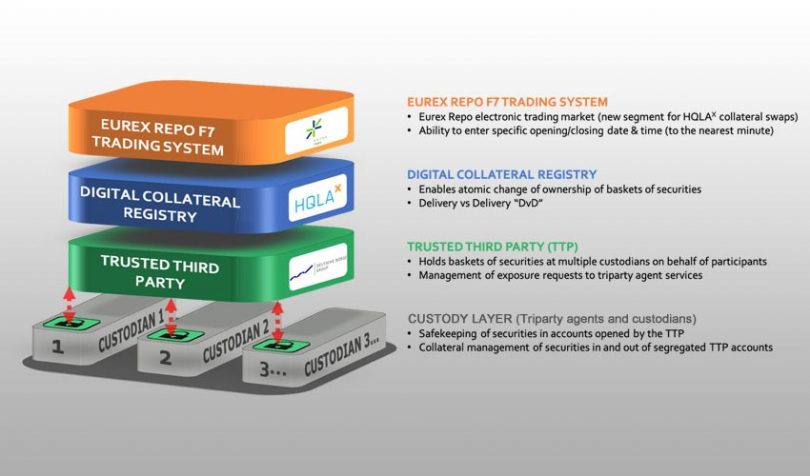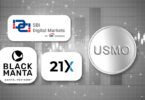The Deutsche Börse-HQLAX distributed ledger technology (DLT) solution for collateral swaps is live. Commerzbank, Credit Suisse and UBS executed the first transactions on the existing Eurex Repo F7 trading system owned by Deutsche Börse. The innovation is that conventional collateral swaps encounter delays while the legal ownership is transferred. Instead, using HQLAX, the securities remain with the existing collateral agents, but the change of legal ownership is recorded on the digital collateral registry.
“The go-live of the HQLAX operating model demonstrates the power of innovation that DLT is already bringing to the financial services industry,” said Jens Hachmeister, Head of New Markets at Deutsche Börse. “It proves how new technology can successfully be combined with trusted market infrastructure – and the positive reception of the model in the market speaks for itself. We look forward to continuing our fruitful collaboration with HQLAX.”
In the first transaction, a basket of corporate bonds was swapped between UBS and Commerzbank, which were both using Clearstream Banking as custodian.
Additionally, UBS and Credit Suisse executed a swap of a basket of corporate bonds for a basket of German government bonds. But in this case, the collateral was custodied at Clearstream and Euroclear Bank respectively. The ownership was transferred without the assets moving between the collateral agents.
Guido Stroemer, HQLAX‘s CEO credited the input from Deutsche Börse, enterprise blockchain firm R3 and the early participants. He explained that the operating model was “designed by the market, for the market.”
“HQLAX delivers a fascinating approach to overcome the fragmented post-trading landscape,” said Peter Schmidt, Co-Head, Repo Desk Treasury at Commerzbank. “It enables treasury departments to manage their collateral pools more efficiently by significantly reducing the settlement cycle and avoiding resource-intensive collateral movements.”
In addition to the participants in these initial transactions, more than 15 other institutions are at various stages of onboarding to the platform. They include CIBC, Citi, Goldman Sachs and ING.
As already reported, J.P. Morgan is in the process of becoming the third tri-party agent, joining Clearstream Banking and Euroclear Bank.
Deutsche Börse previously made two investments in HQLAX, but it made a third investment earlier in the year.
The HQLAX solution is based on R3’s Corda blockchain technology.
While the solution may be a technical feat, there were also regulatory hurdles. “Building the tech was probably the easier part of that equation,” said CEO Stroemer at the recent CordaCon event. “Synchronizing the legal and regs to match the tech took a lot more resourcing and time quite frankly.”
The need for HQLAX and how it works
Banks are required to hold a certain amount of High-Quality Liquid Assets (HQLA) so that they can sell them quickly when needed. But there’s a constant rebalancing of portfolios. The most recent Basel III report estimates that at the end of 2018 the banks that responded held €10.1 trillion ($11.1 trillion) in HQLAs.
When banks trade assets with each other they have to wait for the deals to settle. The idea with HQLAX is that the delay disappears, which makes it especially attractive for intraday trades, something that’s on the startup’s road map.
There’s a four layer process and HQLAX is one of those layers. At the top is the Deutsche Börse owned Repo F7-trading system. When a trade is made, the asset ownership change is logged on the HQLAX layer. But that needs to connect to the custodians or triparty agents who hold the underlying securities. So between the custodians and HQLAX is a Trusted Third Party that makes that connection and is also owned by Deutsche Börse.
Looking ahead
This first iteration provides instant settlement in the form of Delivery versus Delivery.
However, when banks swap assets, invariably the baskets don’t have an identical value so some payment is needed. Or sometimes there may be a straight cash for asset exchange. The instant settlement of the cash leg is not yet supported by HQLAX but delivery versus payment is a planned feature.
Apart from intra day trades, the other two future features mentioned were digital collateral record re-use and support for various types of pledges.






